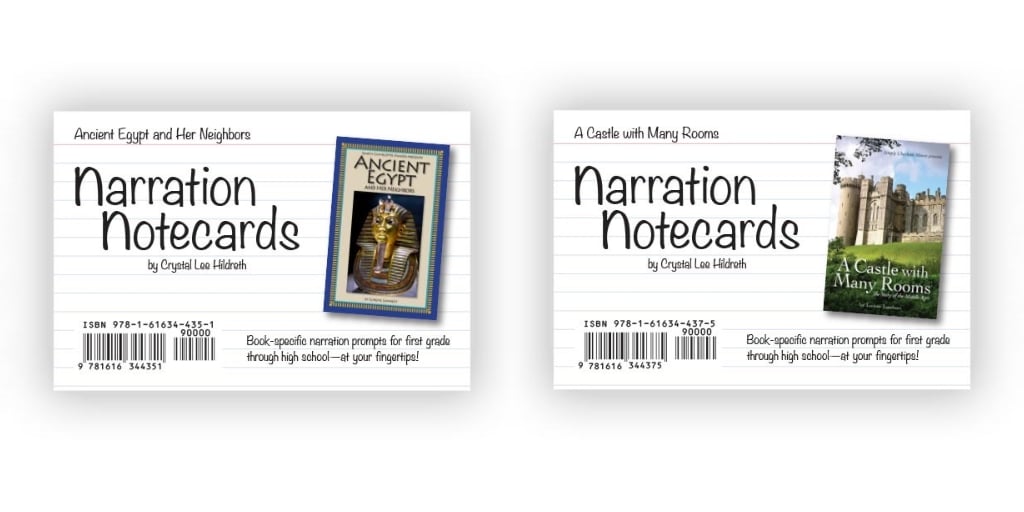Free shipping on USA orders over $129!

Narration is such a powerful tool when done correctly. The foundational way is simply to retell what you read or heard in your own words. If you’re just getting started with narration, you may need to start with reading only a paragraph or one page in order to retain all of that information, process it, mix it with any other ideas already in your mind, confirm any correlations that you notice, put it in the right sequence, form it into your own coherent sentences, and then give it back. There’s a lot of mental work going on! As your student gets more comfortable and more fluent with the shorter passages, you can start nudging out the length that is read before asking for a narration.
Allowing your student to narrate orally is a great place to start. It’s easier to keep up with your thoughts when you are talking, rather than trying to keep up in writing. But again, as your student becomes more comfortable with handwriting and fluent in oral narrations, you can start to transition him to writing his narrations—usually around age 10 or so.
Written narrations bring a couple of challenges of their own. First, how do you encourage correct spelling without allowing your student to look back at the chapter in the book? Second, how do you increase the difficulty level as your student gets older? Written narrations are the training ground for composition skills. And if your student is going to become fluent in various types of composition—expository, descriptive, persuasive, narrative—he needs to have practice in those types of narrations.
Narration Notecards answer both of those challenges beautifully. Today I am pleased to announce the addition of two new sets of Narration Notecards. We now have notecards available for Ancient Egypt and Her Neighbors and for A Castle with Many Rooms: The Story of the Middle Ages.
Narration Notecards help you take narration to the next level by providing chapter-specific narration prompts in a variety of difficulty levels and by providing the spelling of key words from each chapter.
The cards give you three narration prompts to choose from. You can assign a beginner prompt, an intermediate prompt, or an advanced prompt. (They aren’t labeled that way, so your student won’t know which level you have selected.) Feel free to mix them up: some days use the beginner prompt, some days give your student the intermediate assignment, other days challenge him with the advanced narration prompt. Or give him the card and let him choose which one looks interesting to him.
Variety in those prompts will help narration time stay fresh. For example, your student may be instructed to draw a picture and tell about it, to write an interview that reflects what happened in the chapter, trace cause and effect, compare and contrast, draw a map and label it, draw a diagram and label it or tell about it, write an obituary, create a newspaper article, or write diary entries from one character’s point of view.
All of these prompts require the student to think through what was read—to make it his own—and to work with it on a personal level. That mental interaction is what helps to make the knowledge his own possession.
You see, there’s a difference between knowledge and information. Charlotte described it this way:
“The distinction between knowledge and information is, I think, fundamental. Information is the record of facts, experiences, appearances, etc., whether in books or in the verbal memory of the individual; knowledge, it seems to me, implies the result of the voluntary and delightful action of the mind upon the material presented to it . . . the child who has got knowledge will certainly show power in dealing with it. He will recast, condense, illustrate, or narrate with vividness and with freedom the arrangement of his words. The child who has got only information will write and speak in the stereotyped phrases of his text-book, or will mangle in his notes the words of his teacher.”
(School Education pp. 224, 225)
The variety of narration prompts in Narration Notecards encourages your student to move from information to personal knowledge. And the key words—listing people, places, dates, and vocabulary from each chapter—assure that your student will spell those words correctly without looking back at the chapter.
“The Narration Notecards by SCM have transformed our narrations to a new level! I often found myself asking for basic narrative narrations from my middle school students. I knew I needed to raise the bar but doing so happened rarely. By utilizing the notecards our narrations have grown from mostly narrative into expository and descriptive. They are thought provoking and at times spark creativity. I am easily able to give my older students narrations at their own levels. The benefits don’t stop with narration prompts! My children have been able to utilize the word bank on the backside for spelling and to add depth. I was a concerned Momma who may have shed a tear or two over my oldest son’s lack of quality written narrations. I have sat with mouth agape more often than not because of the growth he has shown since expanding our narrations with the cards.”
Tami B.
We are continuing to add new titles to our collection of Narration Notecards. The two new titles available today are notecards for Ancient Egypt and Her Neighbors and A Castle with Many Rooms. You can download a free sample to see how Narration Notecards can take narration to the next level for your students!
Podcast: Play in new window | Download
Podcast (podcastv): Play in new window | Download

Yay!! I am so excited these new resources are here. 😀😀😀
I’ll plan to use these next year when we visit Egypt! Simply Charlotte Mason has been my primary curriculum choice since my current senior in high school was in 5th grade. I absolutely adore your amazing resources and advice. Thank you!